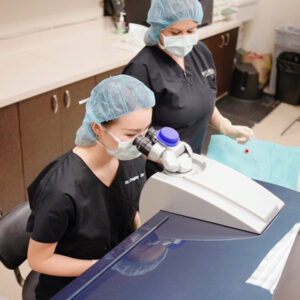ASCRS News: EyeSustain Update
December 2023
by Jake Grodsky, MD, and David Palmer, MD
On Mondays, Wednesdays, and Fridays, I use one bottle of eye drops on many patients. These bottles are not disposed of at the end of the day but are used for months until they expire or run out. Other ophthalmologists use these bottles on their patients as well. However, on Tuesdays, I open a new bottle for each patient and use only one to three drops from each bottle. Often, the patients need these eye drops to use at home, but instead of giving them the bottle that was opened for them, I throw the bottle away and ask them to purchase a new bottle at the pharmacy. These seemingly irrational practices are the reality for many of us in the U.S., where regulatory agencies limit multidosing of perioperative eye drops and don’t allow patients to take their postoperative drops home with them. Given these protocols, it is no surprise that there are regularly 10 or more ophthalmic drugs that remain unavailable on an ongoing basis. In 2022, ASCRS, AAO, AGS, and OOSS endorsed the multisociety position paper on reducing topical drug waste in ophthalmic surgery.1 These guidelines, which summarized the recommendations of the FDA, CDC, and the Accreditation Association for Ambulatory Health Care, stated the following: Topical drugs in multidose containers can be used on multiple patients, they can be used until the labeled date of expiration, and patients should be able to bring their partially used medication home for postoperative use. In this issue’s EyeSustain Update column, Jake Grodsky, MD, and David Palmer, MD, provide practical steps ophthalmologists can take to change perioperative eye drop multidosing protocols at their own institutions and operating rooms.
—Aakriti Garg Shukla, MD, EyeSustain Editor

Drug waste in healthcare is a critical concern. In this context and within ophthalmology, perioperative eye drop use is an important issue on which we can make a significant impact in reducing waste.1 Our particular focus is on perioperative eye drop waste, emphasizing the pivotal role physicians play in recognizing the issue and driving tailored solutions for ophthalmic care.
A common theme among most intraocular surgeons is the need for perioperative ocular anesthesia, dilation, and infection prevention. This is often achieved via administration of different types of eye drops. Unfortunately, at some institutions and ASCs, these drops are used once and discarded, requiring a new bottle for the next patient. The cost of eye drop waste and related carbon emissions produced annually is astronomical,2,3,4 especially at high-volume centers. Patients may find repurchasing these same medications for continued postop care financially and logistically challenging. As a result, we, like so many of our colleagues, advocate for and educate others on the recommendations of a multisociety position paper1 calling for: 1) multidose eye drop use on multiple patients up to the manufacturer expiration date using CDC infection control guidelines, and 2) facilities to allow taking home partially used topical OR medications for postop use when indicated.
We have learned that every institution or ASC is different and has differing rationales to support their policies regarding multiuse eye drops. These can include concerns about sterility and patient safety, government-mandated programs like Section 340B, state laws prohibiting multidosing eye drops, or simply an unchallenged longstanding policy. Nevertheless, the non-alignment between manufacturer labeling and actual practice underscores the need for a closer examination of existing protocols and addressing waste without compromising patient care. Here, we outline a proactive approach for physicians to drive change within their institutions and ORs, emphasizing the importance of persistence, open dialogue, interaction with state eye and medical societies, and a commitment to sustainability.
- Observation and analysis: When physicians observe daily practices with a keen eye toward sustainability, there are bound to be many identified situations where a positive change can be made, such as if eye drops are being used as single-use instead of multiuse and/or patients are not allowed to bring their partially used topical OR medications home.
- Engage in constructive dialogue: Armed with observational insights, physicians should initiate conversations with colleagues, nursing staff, administrators, pharmacists, and state eye and medical societies to determine if facility policies are local or statewide. This dialogue should aim to uncover the reasons behind the current practices and shed light on any concerns that contribute to waste. This might involve revisiting guidelines for drug usage, storage, and disposal, or even investigating and challenging state or national policies. If no such regulatory policy exists, the AAO Topical Medical Waste Reduction Act legislative template is a good starting point to initiate change. It’s essential to approach these discussions with an open mind, seeking to understand issue complexities.
- Challenging the status quo: A common eminence-based refrain of “That’s just the way it is” can often hinder progress. Physicians should persistently question the status quo, asking why certain practices are in place and whether they align with best practices and sustainability goals. It takes courage to challenge this type of mentality and instead dig further for the root cause behind the policy in question.
- Collaboration with administration: After identifying a potential area for improvement, share the data, observations, and concerns that have emerged from these interactions. Work together to develop ideas and suggestions on how to reach those goals without compromising patient care.
- Persistence and enactment: Physicians, alongside administrators, nurses, and pharmacists, should work to finalize these proposed changes. It sometimes takes persistence and creativity to overcome the inevitable roadblocks. By substituting eminence-based attitudes with evidence-based data, physicians have incredible power to challenge assumptions, address concerns, and foster a culture of continuous improvement for the benefit of our patients.
Drug waste and sustainability are important topics that impact us as physicians. As patient advocates, we have the capacity to drive transformative change within our institutions and ORs. Our duty is to enhance patient care while also contributing to a more sustainable healthcare ecosystem valuing efficiency, responsibility, and innovation.
About the physicians
Jake Grodsky, MD
Vitreoretinal Surgery Fellow
Ochsner Health
New Orleans, Louisiana
David Palmer, MD
Clinical Associate Professor
Department of Ophthalmology
Feinberg School of Medicine
Northwestern University
Chicago, Illinois
References
- Palmer DJ, et al. Reducing topical drug waste in ophthalmic surgery: multisociety position paper. J Cataract Refract Surg. 2022;48:1073–1077.
- Tauber J, et al. Quantification of the cost and potential environmental effects of unused pharmaceutical products in cataract surgery. JAMA Ophthalmol. 2019;137:1156–1163.
- Berkowitz ST, et al. Potential cost savings associated with a multiuse preoperative and preinjection eyedrop protocol. Ophthalmology. 2022;129:1305–1312.
- Sherry B, et al. How ophthalmologists can decarbonize eye care: A review of existing sustainability strategies and steps ophthalmologists can take. Ophthalmology. 2023;130:702–714.
Contact
Grodsky: grodskylsu@gmail.com
Palmer: dpalmermd@comcast.net



